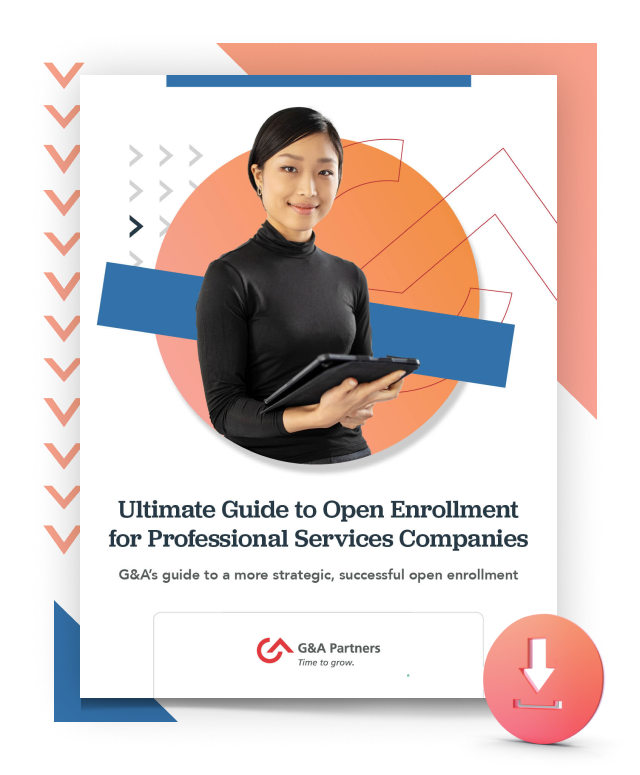During annual benefits open enrollment, your employees make important decisions about health, dental and life insurance, ancillary or voluntary benefits, and more. Yet, many workers report confusion and lack of awareness about benefits options and enrollment deadlines—often resulting in mistakes, frustration, and lost time for employees and HR representatives.
“We can’t take for granted that employees understand the benefits options we are putting in front of them. We need to be strategic about educating them,” said G&A Partners’ Director of Beneficial Jenifer Allbright. “A lack of knowledge can lead to employees choosing plans that don’t meet their needs.”
Following is five ways to help demystify your benefits open enrollment process and set your employees up for success.
#1 Plan to Succeed
After you close this year’s benefits enrollment period, take a short breather and start planning for next year. Meet with your HR representative (or team) and other employees who participated in the process to discuss what worked and what didn’t work—and brainstorm ideas and improvements for next year.
It’s also a good idea to survey your employees to get feedback on difficulties they encountered, what they may need for a smoother process next time, and how they prefer to receive information about available benefits, plans, options, deadlines, and the open enrollment process in general.
Additional steps to consider during your planning process:
- Set employee outreach and enrollment goals
- Develop key messages and create straightforward, direct educational content
- Plan a virtual benefits fair and to distribute pre-enrollment fliers (printed and online) and enrollment packets approximately 6-8 weeks before open enrollment begins
- Conduct open enrollment through a benefits portal for about three weeks
- Collect feedback and suggestions throughout the process
#2 Clarify Common Technologies and Acronyms
When researching insurance and other benefits options, it’s common to come across terms and acronyms that create confusion during the online benefits enrollment process. For example, only 4% of health insurance consumers surveyed by Policygenius and Radius Global Research could accurately define all four of the following basic terms that apply to most health insurance plans:
- Copayment: A fixed amount you pay for a covered healthcare service or prescription drug.
- Coinsurance: The percentage of a covered healthcare service you pay that typically applies after your annual deductible has been met.
- Deductible: A fixed dollar amount you pay for eligible services before your insurance plan begins reimbursing for expenses.
- Out-of-Pocket Maximum: The cap, or limit, on your share of the cost of covered healthcare services in a plan year. When you meet that limit, your health plan will pay 100% of all covered healthcare costs for the rest of the plan year.
Your employees want to make informed decisions and to be clear about what they are getting when they make a choice, so help decipher and simplify the often overwhelming and complicated world of benefits with a glossary of common benefits terms and their definitions.
The goal is to help them learn the details of more common—or bedrock—benefits like medical insurance and introduce them to financial and ancillary benefits like Health Savings Accounts (HSAs), Employee Assistance Programs (EAPs)—and everything in between.
#3 Bridge the Generation Gaps
Employees have different needs at various life stages, so consider generation-specific concerns when designing your company’s benefits open enrollment education and communication programs.
The youngest generation in the workforce—Generation Z (born 1997–2012)—and new workers are often confused by the benefits open enrollment process. “Health care plans, tuition reimbursement, wealth and income protection, and other benefits are foreign to candidates new to the workforce. If they’re not educated on options and how their plans work, they could make unfavorable decisions that have a negative impact on their lives and financial health,” according to Training Industry’s “The Importance of Educating Gen Z Employees on Benefits During Onboarding” by Frank Mengert.
Tips that can help Gen Z employees get a better handle on their benefits offerings:
- Emphasize benefits education in your employee onboarding program
- Educate them on available plan options and common terminologies, such as premiums, copays, and deductibles
- Describe how health savings accounts (HSAs) and flexible spending accounts (FSAs) work and the financial benefits they can realize by enrolling in them
- Provide details of your tuition reimbursement or continuing education programs
- If possible, make your plans customizable
#4 Keep Employees Posted Using Simple, Direct Communications
Providing employees with user-friendly information helps them understand which options are best for themselves and their families. Therefore, your company’s benefits open enrollment communications strategy should be direct, simple, and strategic.
Recommendations on how to ace ongoing benefits communications:
- Use simple language when describing benefits
- Create targeted content that describes how benefits relate to different employees’ lifestyles (single, married with children, near retirement, etc.)
- Distribute information through various methods and forums, including emails, social media, webinars, one-on-one meetings with benefits counselors, office-wide meetings, interactive decision support tools, and videos
- When conducting a meeting, use presentation technologies that reach both in-person and remote employees. Conduct multiple sessions for the convenience of employees who work different shifts or record the meeting and post it so workers can view it anytime
- Use real-world (but anonymous) examples to bring the value of your benefits to life
- Send targeted messages and content to employees several weeks before essential action items, such as the beginning and end of the open enrollment process. Make sure the required actions and deadlines are specific and in bold.
- Survey employees to find out if your communication methods are working or if they prefer information to be distributed differently
- Make sure employees know who they can go to for answers to their questions regarding your open enrollment period and benefits offerings. Set aside time for one-on-one benefits enrollment meetings and to help answer employee questions.
#5 Take Your Benefits Enrollment System Online
If your business uses a paper-based benefits enrollment method, consider switching to an online enrollment system that has useful employee communication tools such as web links, FAQs, benefits enrollment documents, and a glossary of terms. This can help employees make informed decisions based on their needs, save valuable time, and minimize potentially costly errors.
G&A Partners’ online benefits enrollment system scales to your company’s size and needs and can create and send customizable electronic reports to benefits administrators or your HR team so you can track employees’ benefit status and elections.
This type of system also allows employees to:
- Connect to the enrollment system anywhere, anytime, from any computer
- Access educational resources that explain your company’s benefits offerings
- Easily compare plans
- View employee-specific costs associated with each option
- Review and revise their benefits choices
- Access a team of benefits experts for assistance and information about coverage options and enrollment
BONUS: Get Help from a Team of Benefits Experts
An HR outsourcing services provider such as a professional employer organization (PEO) can provide you with access to high-quality, affordable benefits that allow you to compete for top talent, provide employees with the health and financial help they need, and administer your employee benefits program.
Benefits procurement and administration services through an HR outsourcing firm can provide:
- Tremendous buying power that provides greater access to top health care, dental, vision, life, short-term disability, long-term disability, and other types of insurance
- Access to voluntary benefits and employee assistance programs
- Onsite assistance for open enrollment and access to benefits-enrollment technology
- Help with employee calls regarding coverage and claims
- Reconciliation of invoices to ensure the appropriate collection of employee benefit contributions
- Unemployment claims administration
- COBRA administration
- 401(k) plan and administration
- Section 125 Plan administration
- Paid time off (PTO) tracking
How G&A Can Help
Insurance and benefits plans can be cost prohibitive for companies that run smaller operations and/or do not have a large workforce. G&A Partners offers small- and mid-sized companies access to top-quality benefits options by leveraging the buying power of thousands of client companies when negotiating with providers. We also keep your employer insurance premium costs in check so that your company has protection without placing undue stress on your budget. To learn more, schedule a consultation with one of our knowledgeable business advisors


